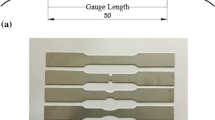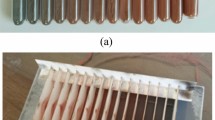Abstract
Several fracture mechanics based models are currently available for defect assessment. These models generally assume that any defects present in the structure are located in materials of uniform properties and make no provision for the possible differences in deformation behaviour of components fabricated with dissimilar material. Extensive research using numerical simulation has been carried out for a number of years at University College of Swansea to investigate the effects of weld mismatch on potential fracture behaviour. However, no detailed validation work has been done to verify the large amount of data generated so far. The work presented in this paper was aimed at filling this gap. Crack tip parameters of single edge notch specimens under pure bending and direct tension were studied using a combination of experimental and numerical techniques. The results of this combined study confirm the validity and accuracy of the numerical procedure used. Comparison of the values of CTOD and J-integral with those obtained using the defect assessment models shows that these models are not adequate even for predicting behaviour of homogeneous specimens. Much research is therefore still required to develop procedures for accurate predictions.
Similar content being viewed by others

References
F.M. Burdekin and M.G. Dawes, in Proceedings of the Institution of Mechanical Engineers Conference, London (1971) 28–37.
C.E. Turner, in Elastic-plastic Fracture: Second Symposium, Vol. II-Fracture Resistance Curves and Engineering Application, ASTM STP 803, C.F. Shih and J.P. Gudas (eds.) (1983) 80–102.
V. Kumar, M.D. German and C.F. Shih, Electric Power Research Institute (1981).
R.A. Ainsworth, Engineering Fracture Mechanics 19 (1984) 633–642.
M.H. Bleackley, Ph.D. thesis, University of Wales (1981).
R.D. Jones, Ph.D. thesis, University of Wales (1984).
M.J. Cray, Ph.D. thesis, University of Wales (1992).
M.M.K. Lee and A.R. Luxmoore, Journal of Strain Analysis 25 (1990) 255–265.
M.M.K. Lee and A.R. Luxmoore, in Proceedings of Asian Pacific Conference on Computational Mechanics, Hong Kong (1991) 891–896.
ABAQUS User's Manual, version 4.8, Hibbit, Karlsson & Sorenson Inc. (1989).
D.P. Rooke and D.J. Cartwright, Compendium of Stress Intensity Factors, Procurement Executive, Ministry of Defence, HMSO, London (1974).
British Standards Institution PD6493, Guidance on methods for assessing the acceptability of flaws in fusion welded structures (1980).
British Standards Institution PD6493, Guidance on methods for assessing the acceptability of flaws in fusion welded structures (1991).
T.L. Anderson, Fracture Mechanics-Fundamentals and Applications, CRC Press (1991).
K.I. Azzabi, A.R. Luxmoore and M.M.K. Lee, International Journal of Fracture (in press) (1993).
Author information
Authors and Affiliations
Rights and permissions
About this article
Cite this article
Lee, M.M.K., Luxmoore, A.R. & Sumpter, J.D.G. A numerical and experimental study on defect assessment of plain and welded bars with shallow crack geometries. Int J Fract 62, 245–268 (1993). https://doi.org/10.1007/BF00012542
Received:
Accepted:
Issue Date:
DOI: https://doi.org/10.1007/BF00012542



